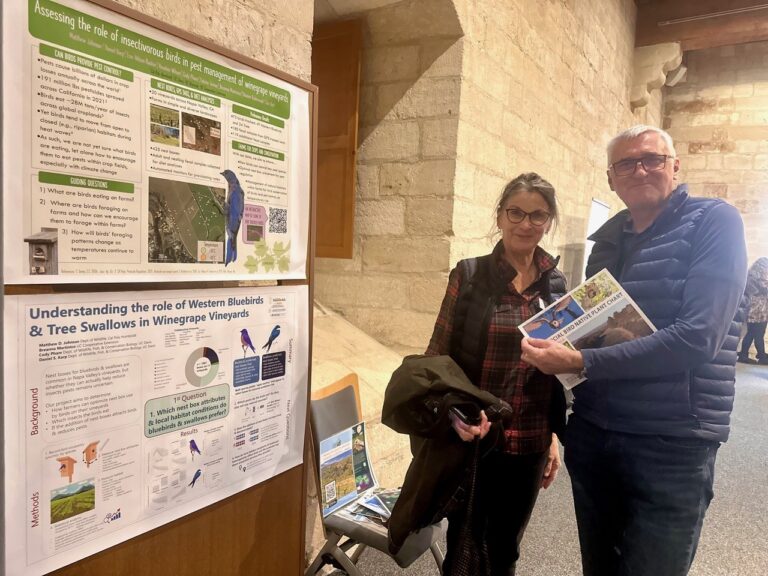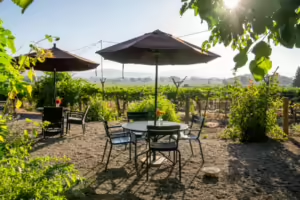
Driving down the dirt road that leads to Tres Sabores on the west side of Napa Valley on prime Rutherford benchland, you might not expect to find a vineyard tucked up against the steep Mayacamas. Oak-forested slopes rise steeply ahead.
Just to the east on the main highway is Grgich Hills’ Rutherford estate. South are the fabled vines of historic Inglenook. This is high-class wine country.
Then there’s homey Tres Sabores, which offers a distinct contrast to the glamor and gussy-uppedness that so much of Napa thrives on. Owner and vintner Julie Johnson would rather talk to you about her pomegranate trees, the latest bird study she’s working on with university researchers (this time it’s four kestrels who’ve nested on her land) or how her goats are eating enough poison oak and undergrowth to keep a fire-safe periphery around the place. It’s a soil-first, nature-friendly place.
But her dry-farmed estate wines keep pace with those illustrious neighbors, winning high praise for both her estate-grown Cabernet Sauvignon ($125 a bottle) and her award-winning, head-trained, historic Zinfandel ($51) from vines planted in 1971.
She buys another 50% of grapes in both traditional and non-traditional varieties; Picpoul Blanc and Saint Laurent, for example, making favorites like a red blend and a rosé. Slow Wine Guide 2024 awarded her 2020 Zinfandel its top award as Slow Wine, giving it its highest rating.
Total production is 3,000 cases.
While two thirds of her land is up steep slopes, she grows grapes on the mostly clay loam bench lands. Most of the vines are 50+ years old, and that includes 10 acres of her major love, dry-farmed old vine Zinfandel, which she’s kept going ever since she acquired the property with her then husband John Williams back in 1987. She also grows Cabernet on 2.5 acres.

Anyone else would have ripped out the Zin (we’re talking the world famous Rutherford bench here) and planted Cabernet, but Johnson remains devoted to the vines, their history and complex, satisfying flavors. She’s a dedicated grower, picking Zin at three different moments in time to capture optimal ripeness.
A Long-Term Relationship with the Land
“We moved to the property in 1987,” said Johnson, a former public health nurse who graduated from Bowdown College in Maine. She raised her family here.
“I’ve had the opportunity to steward this land and to grow into it, and a lot of empathy, really, for this merging of farming with nature we’re surrounded by,” she said.
She and Williams certified the vineyard organic in 1991. Partnered in the wine business with their close friend Larry Turley as Frog’s Leap winery, they were the first in Napa to become certified organic.
Their professional companion on the journey was organic royalty, the legendary Amigo Bob Cantisano, who also married them there under a tree now signed “The Wedding Tree,” a massive oak that is thought to date back to 1660. Cantisano (founder of CCOF, the USDA NOP certifier in California as well as Ecofarm, the organic farmers conference) inspired organic farmers to cultivate biodiversity.
The pioneering Johnson started Women for WineSense, one of the first organizations for women vintners, and created her own label, Tres Sabores, Spanish for “three tastes.” Initially, she intended to work with three winemakers making wine from the same grapes, but found that too challenging to sell commercially. Today, she is the winemaker and is married to another winemaker, Jon Engelskirger.
She thinks of the three tastes now as the land, the vines and the company around the table.
Biodiversity by Design in a Closed Loop Farm System
Part of what attracts tourists, Johnson said, is the feeling of being surrounded by gardens and biodiversity. Guests sit next to the vines and can wander around into the informal, exuberant, agrarian paradise with its vegetable gardens, farm animals, hedgerows and her friendly Golden retrievers. But it’s not about cosmetics; it’s an intimate, high-touch setting with both nature and agriculture, scaled for humans, that pulses with life and authenticity. Small is beautiful.
“People feel like they could do this,” she said. “It’s not so pristine. I think we’ve had the opportunity to create an atmosphere where people can engage. They can put themselves in the position of growing things… that gets people thinking.
“It really is a place where we can welcome people. We have a limited number of seats, but we’re very dog-friendly, we’re very family-friendly… I raised my kids here,” she said.
The property has 10 varieties of pomegranate trees (200 in all), a companion planting Cantisano encouraged, as well as 40+ olive trees, many of which predate her arrival.
“I make all sorts of things from them, and we have a big party to celebrate them. Wherever you find pomegranates, you tend to find grapes. I inherited a growth that was planted sometime in the late 19th century. It’s really quite special.
She’s also planted a lot of lemon trees.
“All the peripheral part of the growing area and the vineyard and all the olive orchards is full of hedgerows that have herbs that are very productive in their own right. They’re feeding these beneficial insects and providing food for birds. So, it comes together as it comes together.”
She also integrates farm animals into the scene.
“We have our own little mini herd of Shetland sheep, and goats, and a lot of chickens, and guinea fowl. And that’s in itself great because those guys in their pens produce a lot of manure, the manure we use with all of the green waste from the production process to make compost. So that’s another kind of thing that kind of makes the world go round.
“And then the guinea hens are there to clean up the fly larva, and to be part of the whole system, as well as are the chickens. And then the chickens use scraps from the winery and… help fill our compost bin.
“The animals on the property can eat the grass and the cover crop and so on.
“I’ve re engaged with goats. Right now, we have the second litter of goats. And they eat brush up in the hills, reducing the fire danger.”
A Living Lab
Johnson never stops thinking about what’s next for her farm ecosystem.
“I look at my property as kind of a laboratory,” she said. “It’s really so small, 35 acres with 12 planted. But I try to see what we can do to build more soil health and feed the soil microbiome. It’s really about the understanding that we’re feeding the soil and living with the soil, and it’s the soil that feeds the vines.”
The same spirit of creativity and adventure applies to her wine business and guest engagement: hosting weddings, mixing in dance group performances and art, and building more word of mouth.
She sells estate-grown pomegranate vinegar and olive oil. Wine club members can give their friends and families free visits. Picnicking is allowed. She also hosts events (with a super long table) and partners with the renowned “Outstanding in the Field” group, which hosts large-scale public gourmet meals with celebrated chefs ($395 a head). She’s also big on food photos on her Instagram feed.
All of which has led to acclaim. The San Francisco Chronicle named Tres Sabores “A Top Winery in Napa Valley.” Similarly, Lonely Planet calls it “a top choice in Napa Valley.”
Being family-friendly, dog-friendly and nature-friendly turns out to be a winning strategy in even the most competitive and concentrated wine tourism region. Excellent wine is a must, too. Tres Sabores’ sense of people and place, wine and values clearly appeals.
Award-Winning
Today, Johnson’s winery is a word-of-mouth hit with tourists as exemplified by a recent prestigious wine tourism award.
In 2023, Great Wine Capitals honored her as the regional winner of the Best of Wine Tourism Award in the Sustainable Wine Tourism Practices category, a high bar to meet in Napa, to be sure.
“I don’t know who even nominated us,” she said. But read the rave reviews on Yelp and TripAdvisor and it’s easy to understand why this honor came her way.
“What a gem of a place, so different from other large wineries. It is a farm and it feels like it; the whole experience is very authentic,” said one reviewer.
“They offer pet-/dog-friendly tastings outdoors right next to the vineyard so you can sip your wine overlooking the vast grounds,” said another.
And another: “Unlike some of the other places we’ve visited, Tres Sabores is very relaxed and off the beaten path; the ambiance is peaceful and you aren’t rushed through the tasting.”
And these: “It was picture-perfect in every corner and definitely felt like heaven on earth. I can totally sit there all day!”
“Sheep and dogs and wonderful wine and service make this a must stop!! Ambiance is peace, calm and beauty.”











